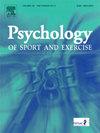Examining the impact of perceived behavioral control and planning on closing the exercise intention-behavior gap: Insights from a meta-analytic structural equation modeling study
IF 3.1
2区 心理学
Q2 HOSPITALITY, LEISURE, SPORT & TOURISM
引用次数: 0
Abstract
Objective
This study aims to investigate the roles of perceived behavioral control (PBC), action planning, and coping planning in bridging the gap between exercise intention and behavior. By using a Meta-Analytic Structural Equation Model (MASEM), we quantify the specific effects of these variables and explore their mediating roles in the relationships between intention, PBC, and behavior. The study provides insights into how these constructs contribute to informing effective behavioral intervention strategies.
Methods
A meta-analysis was conducted to calculate the correlation effect sizes between variables in the model, and MASEM was employed to examine the interrelationships among multiple variables. Data from 57 samples across 49 studies, with a total sample size of 19,883, were analyzed. We constructed an aggregated correlation matrix and performed path analysis using structural equation modeling. AMOS 26.0 software was used to estimate model parameters, including path coefficients, standard errors, and various model fit indices.
Results
The results indicate that behavioral intention serves as a key predictor of behavior, showing a significant positive direct effect (β = 0.416, p < 0.001). Intention also significantly predicts both action planning (β = 0.439, p < 0.001) and coping planning (β = 0.360, p < 0.001), though its impact on behavior is mediated differently by these two forms of planning. Mediation analysis further revealed that intention indirectly predicts behavior through coping planning (β = 0.067, p < 0.001), while the mediation effect through action planning was not significant (β = −0.001, p > 0.05). PBC played multiple roles: it directly predicts behavior (β = 0.106, p < 0.001), indirectly predicts behavior through intention (β = 0.282, p < 0.001), and further mediates behavior through intention and coping planning (β = 0.046, p < 0.001), as well as through coping planning alone (β = 0.032, p < 0.001). Additionally, the mediation effect of PBC on behavior through action planning was statistically significant but negligible (β = 0.000, p = 0.003), reinforcing the stronger role of coping planning in driving behavior change.
Conclusion
This study highlights the important roles of behavioral intention and perceived behavioral control in promoting physical activity while challenging the effectiveness of focusing solely on action planning. The findings suggest that although action planning does not significantly impact behavior, coping planning plays a critical role in behavior implementation. By integrating action planning and coping planning, comprehensive behavioral intervention strategies can more effectively bridge the intention-behavior gap and promote sustained physical activity.
检查感知行为控制和计划对缩小运动意图-行为差距的影响:来自元分析结构方程模型研究的见解。
目的:探讨感知行为控制(PBC)、行动计划和应对计划在弥补运动意图与行为之间的差距中的作用。通过meta分析结构方程模型(MASEM),我们量化了这些变量的具体影响,并探讨了它们在意图、PBC和行为之间的关系中的中介作用。该研究为这些结构如何有助于告知有效的行为干预策略提供了见解。方法:采用meta分析计算模型中变量之间的相关效应量,采用MASEM检验多变量之间的相互关系。研究人员分析了49项研究中57个样本的数据,总样本量为19883人。我们构建了一个聚合的相关矩阵,并使用结构方程模型进行路径分析。采用AMOS 26.0软件估计模型参数,包括路径系数、标准误差和各种模型拟合指标。结果:行为意向是行为的关键预测因子,具有显著的正直接效应(β = 0.416, p < 0.001)。意向对行动计划(β = 0.439, p < 0.001)和应对计划(β = 0.360, p < 0.001)也有显著的预测作用,尽管其对行为的影响在这两种计划形式中有不同的中介作用。意向通过应对计划间接影响行为(β = 0.067, p < 0.001),而行动计划的中介作用不显著(β = -0.001, p < 0.05)。PBC具有多重作用:直接预测行为(β = 0.106, p < 0.001),通过意图间接预测行为(β = 0.282, p < 0.001),通过意图和应对计划进一步调节行为(β = 0.046, p < 0.001),以及单独通过应对计划调节行为(β = 0.032, p < 0.001)。此外,PBC通过行动计划对行为的中介作用具有统计学意义,但可以忽略不计(β = 0.000, p = 0.003),这说明应对计划对行为改变的驱动作用更强。结论:本研究强调了行为意向和感知行为控制在促进身体活动中的重要作用,同时挑战了仅仅关注行动计划的有效性。研究结果表明,虽然行动计划对行为没有显著影响,但应对计划在行为实施中起着关键作用。综合行为干预策略通过整合行动计划和应对计划,可以更有效地弥合意向-行为差距,促进持续的身体活动。
本文章由计算机程序翻译,如有差异,请以英文原文为准。
求助全文
约1分钟内获得全文
求助全文
来源期刊
CiteScore
6.40
自引率
5.90%
发文量
172
审稿时长
69 days
期刊介绍:
Psychology of Sport and Exercise is an international forum for scholarly reports in the psychology of sport and exercise, broadly defined. The journal is open to the use of diverse methodological approaches. Manuscripts that will be considered for publication will present results from high quality empirical research, systematic reviews, meta-analyses, commentaries concerning already published PSE papers or topics of general interest for PSE readers, protocol papers for trials, and reports of professional practice (which will need to demonstrate academic rigour and go beyond mere description). The CONSORT guidelines consort-statement need to be followed for protocol papers for trials; authors should present a flow diagramme and attach with their cover letter the CONSORT checklist. For meta-analysis, the PRISMA prisma-statement guidelines should be followed; authors should present a flow diagramme and attach with their cover letter the PRISMA checklist. For systematic reviews it is recommended that the PRISMA guidelines are followed, although it is not compulsory. Authors interested in submitting replications of published studies need to contact the Editors-in-Chief before they start their replication. We are not interested in manuscripts that aim to test the psychometric properties of an existing scale from English to another language, unless new validation methods are used which address previously unanswered research questions.

 求助内容:
求助内容: 应助结果提醒方式:
应助结果提醒方式:


